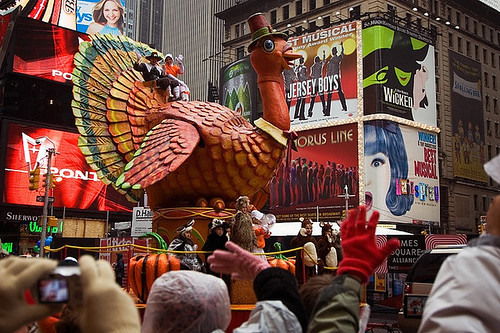The iconic event may not be as feel-good as it seems
By CLARA FISCHER — arts@theaggie.org
The Macy’s Thanksgiving Day Parade has long been a tradition associated with the holiday. Dating back to 1924, it originated as a Christmas celebration, and has since evolved into one of American Thanksgiving’s most recognizable trademarks.
However, it seems a bit odd that so many celebrate the holiday of giving back by watching what is, at its core, a glorified three-hour long commercial.
While the parade is expensive (some experts estimate that Macy’s spends upwards of $10.4 million on the ordeal every year) and some may not see it as a worthy investment for a company that is one of the last remaining giants of the dying department store industry, the exposure Macy’s gets from the event far surpasses the costs of putting it on.
From an economic viewpoint, the branding is ingenious — the Macy’s name is so synonymous with the affair that many refer to it simply as “The Macy’s Day Parade.”
This kind of brand recognition provides exposure that comes at a critical time in the year. The parade takes place from 9 a.m. EST to 12 p.m. EST on Thanksgiving Day — a time during which many American families are relaxing before going through the stress of cooking Thanksgiving dinner. More importantly, it streams just before the biggest commercial event of the year: Black Friday.
By hosting the extravagant march of themed floats and giant helium balloons just mere hours before the dawn of the shopping event, Macy’s discreetly plants the brand in consumers’ subconscious minds, increasing their likelihood of making a stop at the department store as they hunt for deals.
To maximize the chances of this happening, the marketing of the event has been aimed at children. The goal is to entice the younger demographic with giant blown-up versions of their favorite cartoon characters in the hopes that they will influence their parents to purchase the correlating merchandise at Macy’s (which, conveniently, is already on sale for Black Friday).
Another important note is that while the parade has been running since 1924, the first Native American land acknowledgment — commemorating one of the most important historical and cultural aspects of Thanksgiving — did not come until 2020, more than 70 years after it first aired. This major delay seems to show that the event was designed as a glittering commercial spectacle that seeks to glorify the materialistic spirit of the holiday season.
While it is easy to tune out and enjoy the entertaining cultural spectacle powered by sheer human ingenuity (one individual balloon can take up to a year to develop before it is ready to fly), there seems to be something sinister about the grandeur of the whole performance.
At the end of the day, viewers can interpret the parade as something put on in the hopes that consumers will be swayed to give Macy’s their money, or they can see it as a longstanding holiday tradition that delights families across the nation. Either way, it’s important to keep in mind the complex history of the holiday and make the most out of the non-materialistic heritage that comes with the season of giving back.
Written by: Clara Fischer — arts@theaggie.org




